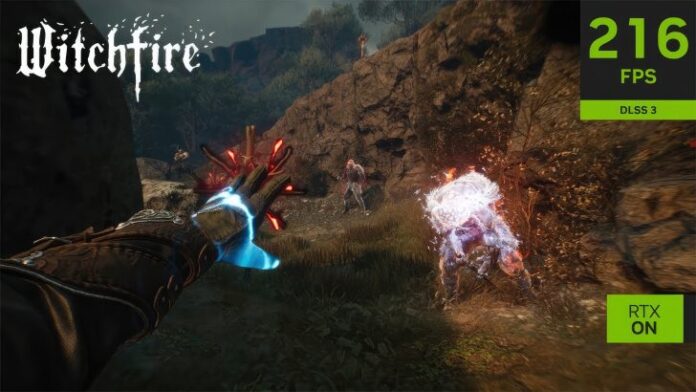
Polish indie studio The Astronauts launched Witchfire in early access last week via the Epic Games Store. It's the developer's second game following The Vanishing of Ethan Carter, and it's a completely different genre (rogue-lite dark fantasy first-person shooter) compared to that game.
In January 2023, the studio confirmed NVIDIA DLSS 3 support, stating that it was a no-brainer addition to Witchfire since it allowed the seemingly impossible in terms of frame rate and visual quality.
In my pre-launch interview with founder and CEO Adrian Chmielarz, he said of NVIDIA's technology:
With only 67% of sharpness, let’s call it that, the image upscaled to 100% is maybe 1% worse than if it was directly rendered to 100%. It sounds weird, it sounds impossible, but that’s the truth. And the framerate boost is phenomenal. So, for the low price of 1% of image degradation, which is basically nothing, you get a much better experience. I love it.
Today, NVIDIA has posted a DLSS comparison trailer that shows the game running at over 200FPS with DLSS 3, touting a 2.x3 performance boost over DLSS OFF.
However, you have to keep in mind that NVIDIA always tests 4K games in Performance mode (upscaling from 1080p). Secondly, the comparison is always DLSS off to DLSS 2 (Super Resolution) + 3 (Frame Generation) on.
In Witchfire, though, DLSS Frame Generation is barely an improvement, at least in my testing with a Ryzen 7 7800X3D CPU, RTX 4090 GPU, and 32GB of DDR5 RAM. Graphics settings were all set to Ultra, with DLSS Super Resolution in Quality mode (upscaling from 1440p).
As you can see in the capture below, the average frame rate only went up by 16 frames per second, a mere 8.2% boost. The 1% percentile FPS fared comparatively better - DLSS 3 gained 15.6 frames per second, but the percentage improvement is more than doubled (18.2%). However, the 0.2% percentile FPS is only 1.8 FPS, or 4.4%, improved with DLSS 3 enabled.

Even worse, the 0.2% percentile FPS is over half lower than the 1% percentile figure. This translates into a poor experience where stuttering is very noticeable despite the high average frame rate. According to CapFrameX, over 2.1% of the frames were afflicted by stuttering even when DLSS 3 was enabled. That's a much higher percentage than most games I tested recently, which all registered 1% or less of the captured frames classified under stuttering.
It's definitely something the folks at The Astronauts need to improve over the course of the early access period. As for the DLSS 3 performance boost, it's possibly the smallest one I've seen yet. If I were to hazard a guess, I'd say it's due to the lack of advanced rendering features like ray tracing and the fact that there's no world simulation here. While Witchfire does feature open-ended maps, they're fairly small, and there are no NPCs except the ones you have to kill.
DLSS 3 was originally conceived to unlock performance in CPU-bound games. As such, it thrives with complex games that offer detailed world simulations, such as Flight Simulator, Cyberpunk 2077, and the like. Here, DLSS Super Resolution (or one of the other upscalers - the game already supports them all) is more than enough on its own.
Gamers equipped with an RTX 4080 or RTX 4090 GPU should have more than enough average FPS (stutters notwithstanding) to use DLAA instead of DLSS. Witchfire doesn't have native support for it, though you could try with the DLSSTweaks tool.
On the plus side, the game already includes graphics settings like Field of View (FoV) slider, FPS limiter, and toggles for post-processing effects like Chromatic Aberration, Bloom, Motion Blur, Vignette, Grain, Lens Flares, and Depth of Field. The Astronauts deserve some kudos here, as we've seen plenty of triple-A studios failing to provide the same level of customization. However, the controller support is currently incomplete, as there's no rumble functionality.
WccftechContinue reading/original-link]




